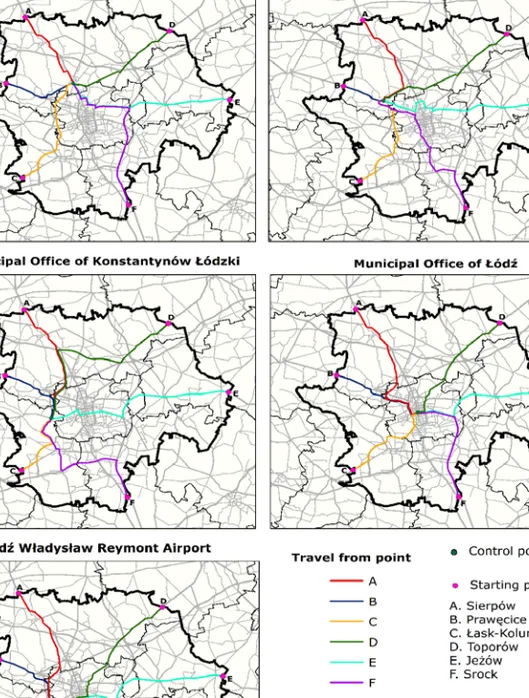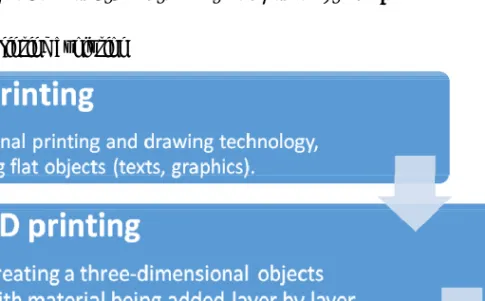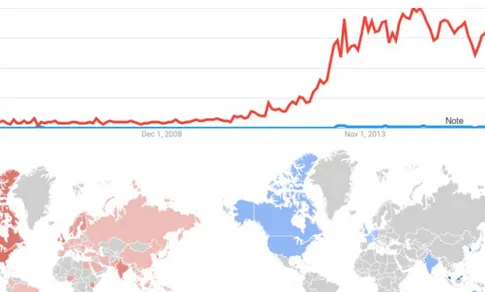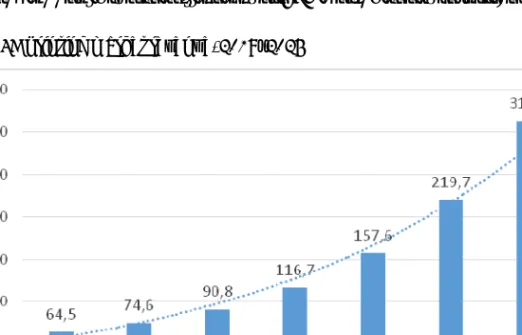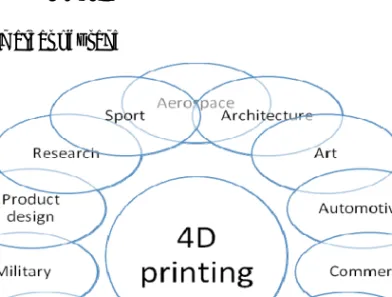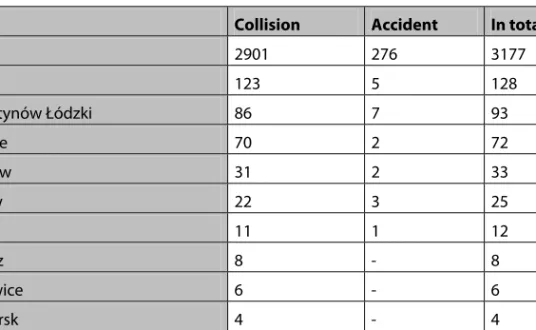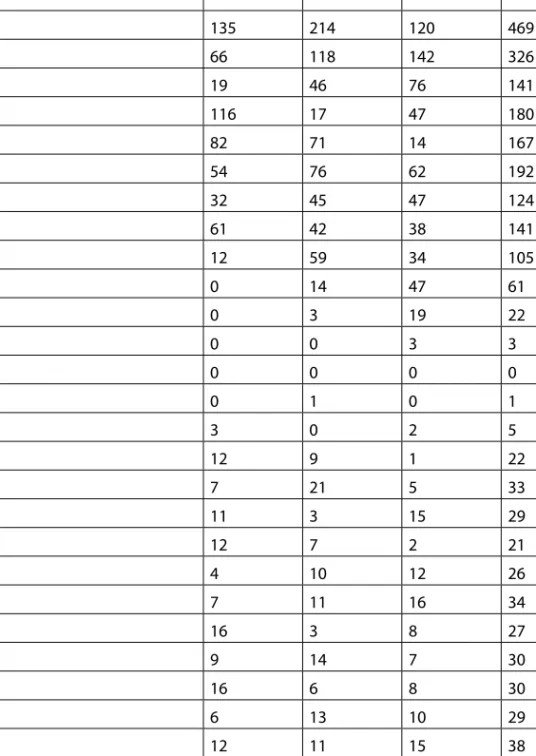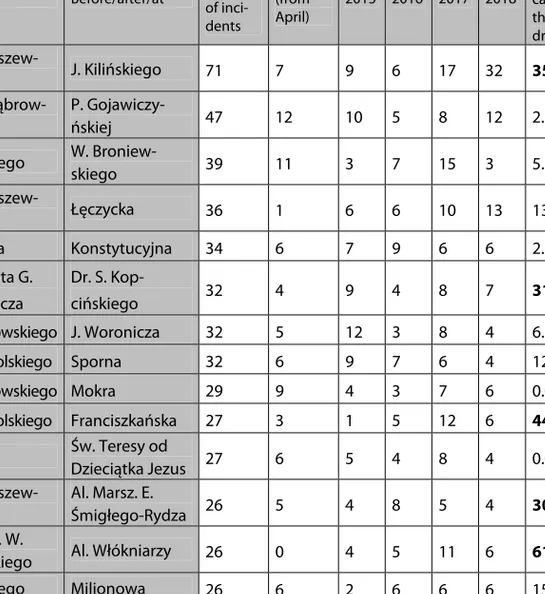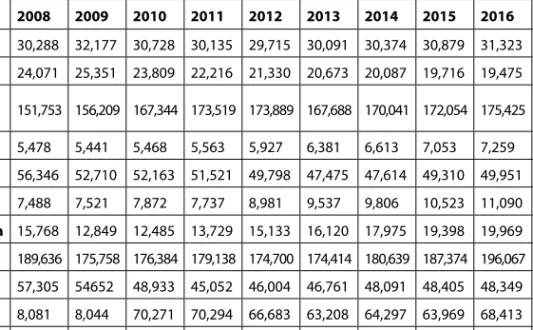Zeszyt recenzowany
Redakcja naukowa: Łukasz Sułkowski, Katarzyna Kolasińska-Morawska Paweł Morawski
Korekta językowa: Małgorzata Pająk, Lidia Pernak, Dominika Świech, Agnieszka Śliz Komputerowy skład tekstu: Jadwiga Poczyczyńska
Projekt okładki: Marcin Szadkowski
©
Copyright: Społeczna Akademia Nauk
ISSN: 2543‐8190
Wydawnictwo Społecznej Akademii Nauk e‐mail: wydawnictwo@spoleczna.pl tel. 42 664 22 39 w. 339 Wersja elektroniczna jest wersją podstawową publikacji, dostępna na stronie: http://piz.san.edu.pl
Spis treści
Wstęp ...7 Część I – Infrastruktura, nowe technologie
Remigiusz Kozłowski, Angelika Pietruszka
Temporal Accessibility Improvement as an Element of Infrastructure Development Management in the Łódź Metropolitan Area
on an Example of the S14 Expressway ... 11
Łukasz Wiechetek, Arkadiusz Gola
4D Printing an Innovative Technology for Creating Agile, Shape
Morphing Products Meeting Individual User Needs... 23
Remigiusz Kozłowski, Klaudia Stanik
Security Management in Urban Logistics Using a Tram Driving
Simulator in MPK Łódź... 37
Ryszard Janikowski
Unpredictability as a Generator of Decision-Making Dilemmas... 53
Część II – Rozwiązania zwinne w przemyśle a zrównoważony rozwój
Anita Fajczak-Kowalska, Magdalena Kowalska
Innovation of Manufacturing Enterprises in Central and Eastern Europe... 65
Danuta Janczewska
Problematyka zarządzanie logistyką zaopatrzenia przedsiębiorstwa
w aspekcie zrównoważonego rozwoju... 77
Magdalena Kowalska
Sustainable Development of Enterprises from the TSL Sector in Poland and Central and Eastern Europe – a Comparative Analysis... 91
Część III – Zwinne zarządzanie obsługą klienta, marką oraz analiza sentymentu
Mirosław Antonowicz, Grzegorz Mirowski, Justyna Abramowska
Zwinne zarządzanie na rzecz skutecznej obsługi klienta
– przykład działań PKP S.A. ...107
Anna Baj-Rogowska
Analiza sentymentu jako narzędzie monitorowania wyników
finansowych przedsiębiorstwa ... 125
Barbara Kucharska, Mirosława Malinowska
Wirtualizacja obsługi klienta w handlu detalicznym – perspektywa
przedsiębiorstwa i klienta... 141
Dagna Siuda
Wpływ czynników demograficznych na członkostwo w wirtualnych
społecznościach marek... 157
Część IV – Zwinność w hipermedialnym środowisku Internetu Jolanta Bieńkowska
Psychosocial Context of Building a Personal Brand in Social Media... 171
Mirosław Moroz
Konkurowanie w przestrzeni wirtualnej w warunkach rosnącej koncentracji rynkowej –przykład segmentu płyt wideo i muzycznych ... 183
Robert Wolny
Nowe technologie a rozwój prosumpcji na rynku usług
gastronomicznych... 199
Konrad Porębski, Łukasz Zakonnik
Analiza wpływu określonych czynników na decyzje zakupowe polskich e-konsumentów – badania ekspertów ... 213
Część V – Zwinność w zastosowaniach praktycznych Karolina Grobelna, Stefan Trzcieliński
The Impact of Organizational Climate on the Regularity of Work Speed of Agile Software Development Teams ... 229
Michał Trziszka
Definicja modelu zarządzania systemem pracy zdalnej w branży IT ... 243
Magdalena Hofman-Kohlmeyer
Postawy użytkowników wobec lokowania marek w grach
komputerowych... 259
Jacek Jakieła, Joanna Wójcik
Wykorzystanie podejść zwinnych w projektowaniu uniwersyteckich kursów blended-learning – przegląd najpopularniejszych metodyk
oraz wizja możliwych ulepszeń ... 273
Antoni Kolek
Sieć 5G – dotychczasowe zastosowania i nowe możliwości
Wstęp
Nowoczesne zarządzanie w dobie dynamizacji przestrzeni społeczno-gospodarczej wykorzystuje innowacyjne koncepcje uwzględniające zmien-ność, unikalzmien-ność, transparentzmien-ność, realzmien-ność, innowacyjzmien-ność, skuteczność oraz efektywność. Różnorodność obszarowo-funkcjonalna podmiotów działają-cych na rynku sprawia bowiem, że aby odnosić sukcesy rynkowe, należy sto-sować nie jedną koncepcję, a całą wiązkę koncepcji, balansując między naj-bardziej pożytecznymi komponentami każdej z nich. Przy czym koncepcje z zakresu zasobów ludzkich, zaopatrzenia, produkcji, dystrybucji, marketingu, obsługi klienta, logistyki, finansów oraz rachunkowości scala integrujące spo-iwo w postaci nowych technologii.
Wykładnicze przyspieszenie rozwoju technologicznego, rozprzestrzenianie się cyfryzacji, internetyzacji oraz autonomizacji maszyn sprawia, że klasyfiko-walność świata według klasycznych norm podziału przestaje mieć rację bytu. Niektórzy znawcy tematu zdają się wręcz wieścić śmierć klasycznej ekonomii oraz klasycznych strategii „Starych koncepcji nie da się stosować w nowym świecie”. Akomodacja, adaptacja, zmienność i zwinność powinny stanowić element zarządzania współczesnych organizacji, w tym w szczególności przedsiębiorstw, jako bytów socjo-gospodarczych integrujących ludzi, ziemię, infrastrukturę i pieniądze. Niwelacja przestrzennych granic sprawia, że obec-nie przedsiębiorstwa mogą działać wszędzie tam, gdzie są ich klienci. Po-wszechność Internetu sprawia, że Ci, którzy gromadzą szybciej większą ilość informacji, mogą szybciej przekonfigurować sposób prowadzenia biznesu, dostosowując go do zmieniających się potrzeb i oczekiwań klientów.
„Jedyną stałą rzeczą w życiu jest zmiana” – jak powiedział starożytny filo-zof. Współczesny uczony rozwinąłby tę myśl, dodając jeszcze „zwinność, cy-frowość, infoniczność oraz integratywną autonomiczność”. To parametry de-skrypcyjne opisujące wymiarowo przyszłość egzystencji zarówno ludzi, orga-nizacji, jak i całych społeczeństw. Transhumanizm, jako rozprzestrzeniający się nurt intelektualny sprawia, że przewartościowaniu ulega sposób rozumienia świata. Ci, którzy nadążą za tymi zmianami, będą wygrani. A ci, którzy się za-trzymają, mogą stracić nie tylko szansę na rozwój, ale i na egzystencję. Umie-jętne zbalansowanie, dostosowanie w nurcie agile może stanowić jedyne
8
rozwiązanie. I właśnie taka różnorodność spojrzeń w nurcie zwinności i ela-styczności dostosowań została zaprezentowania w artykułach zawartych na kartach niniejszego tomu.
W pierwszej części publikacji zebrane zostały artykuły prezentujące zagad-nienia dotyczące infrastruktury logistycznej oraz nowych technologii takich jak 4D. Tę cześć tomu zamyka bardzo ciekawy artykuł na temat dylematów decyzyjnych powodowanych nieprzewidywalnością i sposobów radzenia sobie z tym problemem.
Druga część tomu prezentuje artykuły dotyczące innowacyjnych rozwiązań zwinnych w przemyśle, jak również teksty odnoszące się do koncepcji zrów-noważonego rozwoju, która w czasie silnych działań proekologicznych ma bardzo istotne znaczenie także w biznesie.
W kolejnej, trzeciej części poniższego tomu zebrane zostały artykuły poru-szające zagadnienia związane z wirtualizacją procesów obsługi klienta oraz uczestnictwem w wirtualnych społecznościach marek. Mamy tutaj także bar-dzo ciekawe badania i wnioski na temat analizy sentymentu, jako narzędzia do monitorowania wyników finansowych przedsiębiorstw.
Czwarta część tomu stanowi zbiór artykułów dotyczących aspektów zwin-ności w hipermedialnym środowisku Internetu. Autorzy omawiają tu kwestie dotyczące wykorzystania mediów społecznościowych, procesu decyzyjnego w zakupach online oraz prosumpcji w wirtualnym środowisku Internetu.
Ostatnia, piąta cześć tomu obejmuje artykuły dotyczące zwinności w za-stosowaniach praktycznych. Autorzy przedstawiają możliwości, jakie daje praca zdalna oraz wyniki wpływu klimatu organizacyjnego na efektywność pracy zespołów programistycznych. Zaprezentowano tu także praktyczne, zwinne podejście do projektowania uniwersyteckich kursów e-learningowych. Podsumowując, niniejsza publikacja obejmuje szerokie spektrum zagad-nień związanych z problematyką zwinności w ujęciu organizacyjnym, proce-sowym i techniczno-narzędziowym. Cyfryzacja, internetyzacja i wirtualizacja stały się interesującym wyzwaniem dla naukowców i badaczy. Ich wiedza i doświadczenie są mocnym fundamentem niniejszego tomu.
Szanowny Czytelniku, oddając w Twoje ręce niniejszy tom, redaktorzy żywią nadzieję, iż jego lektura stanie się inspiracją do dalszych poszukiwań i badań w zakresie wykorzystania metod i technik zwinnych w nauce i praktyce.
Życzymy owocnej lektury
Łukasz Sułkowski Katarzyna Kolasińska-Morawska Paweł Morawski
Część I
PRZEDSIĘBIORCZOŚĆ I ZARZĄDZANIE 2019
Wydawnictwo SAN ISSN 2543-8190 Tom XXZeszyt 12 Część 1 ss. 11–22
Remigiusz Kozłowski1
Wydział Zarządzania, Uniwersytet Łódzki ORCID ID: 0000-0003-2781-5341
Angelika Pietruszka2
Wydział Zarządzania, Uniwersytet Łódzki
Temporal Accessibility Improvement as an Element
of Infrastructure Development Management in the Łódź
Metropolitan Area on an Example of the S14 Expressway
Abstract: The article contains information about infrastructure development management from the point of view of benefits in the area of logistics. It presents relationship between transport infrastructure and temporary accessibility to voivodship cities. In addition, road in-vestments in the Lodz Metropolitan Area are also characterized. This article also presents vari-ants of the shortest travel time from starting points to test points before the construction of S14 and after its implementation. The purpose of the article is to examine how the time avail-ability of selected research points will change after the construction of the missing sections of the S14 road. Based on the analyzes, a number of conclusions were formulated regarding the impact of the construction of the S14 expressway on travel time to selected research points. Key words: infrastructure development management, temporal accessibility, Łódź Metropoli-tan Area, S14 expressway.
Introduction
Contemporary economy and the pace of life are constantly accelerating. In order to catch up with this tendency, one has to look for some possibilities to save time. This is a difficult task, particularly when instead of individuals we
1 rjk5511@gmail.com
Remigiusz Kozłowski, Angelika Pietruszka
12
consider a whole urban area, a city, or its fragments. Then it turns out that this is possible, however, some large investments are required, including con-struction of city bypasses. In the Łódź region, such a bypass is the S14 ex-pressway. It has been awaited for years, but it is still not clear when it will be fully available, which of its junctions will be constructed soon, and the con-struction of which will be postponed.
It is commonly expected that one of the benefits it will provide will be the possibility to save time. This expectation is purely intuitive. This article pre-sents analyses that answer the question of whether it will be possible to save time, and if yes, then how much time we will be able to save. It also includes an attempt to identify routes that will or will not allow to save time. The aim of the article is to identify changes in temporal accessibility to selected control points that will occur after the missing sections of the S14 expressway have been constructed. This article was funded by a Student Research Grant awarded by the Vice-Chancellor of the University of Łódź in 2018.
Infrastructure development management from
the perspective of logistical advantages
Logistical possibilities depend on the possibilities of the logistical infrastruc-ture [Wolf-Rüdiger, Karim 2012, p. 10; Kozłowski 2011, p. 145]. Thus, in order to enable the development of logistical services, it is necessary to extend or construct new infrastructure elements [European Bank for Reconstruction and Development 2005, p. 1; Kozłowski, Tomczyk 2009, p. 9].
Such projects are difficult, yet extremely important. Their difficulty results from the fact that they require large financial outlay, and the governments of Members States are not always able to make it. Fortunately, the European Union can be of help, offering financial support [Milio 2013, p. 145; Oude-naren 2005, p. 163] which, in the case of road project, can cover up to 75% of the amount required.
Poland has serious deficiencies in logistical infrastructure, including road transport infrastructure. Since the moment Poland joined the European Un-ion, more than 40% of the target road and motorway network have been con-structed. The greatest progress was made when our country prepared for the European Football Championship in 2012. Many roads are still at different stages of construction. After the event, the dynamics of these projects dropped considerably. However, completion of the logistic infrastructure should remain a priority for our country. In the long run, if our infrastructure is
Temporal Accessibility Improvement as an Element of Infrastructure Development Management…
13
not comparable to the one of our neighbours and other EU Member States, we will not be able to successfully compete with them in economic terms or to offer adequate standard of living, which is a factor influencing young peo-ple’s decision about leaving Poland.
Looking for specific measures, temporal accessibility was selected, which can be deemed useful with regard to the impact assessment of a specific ex-pressway section in the context of logistical service development and its ef-fect on the society. The following part of the article presents characteristics of this measure and some practical analyses employing it.
Significance of temporal accessibility in logistics on an
example of the construction of motorways and expressways
Temporal accessibility is one of the basic conditions for regional development [Komornicki, Śleszyński, Rosik et al. 2009, p. 41] and for the establishment of the socioeconomic spatial structure of a given country [Śleszyński 2014, p. 178]. An accessibility study is a multiple-criteria analysis. It depends on the mode of transport (road, rail, water, air, or multimodal) and the transport type (passenger or freight). When analysing passenger transport, one has to con-sider both individual transport (mostly by passenger cars) and public trans-port [Bocheński 2018, p. 108].
The literature distinguishes different categories of temporal accessibility for people travelling by car. One of them is gross travel time, which is the total time necessary to cover the distance between two selected points, while net travel time is the time only spent on travelling by the means of transport. There is also net driving time, which is calculated without any stops at traffic lights or in traffic jams. The last category described in the literature is gross driving time, which is calculated as the time necessary to cover the distance between two points without pulling over [Śleszyński 2014, p. 182].
Temporal accessibility is also influenced by such factors as the structure and density of the road network. The construction of roads eliminates com-munication bottlenecks, considerably improving the traffic flow and shorten-ing the travel time. The network of roads and motorways should be devel-oped with the aim to complete the most important transport routes, and to create a coherent communication network. It is also important to continue work on the main national roads in order to raise the standard of travel be-tween the main centres of the country by improving the road quality. Short-ening the travel time between selected points also has a major effect on the
Remigiusz Kozłowski, Angelika Pietruszka
14
comfort of travel. Shorter travel time raises the standard of living of the popu-lation and improves the quality of work. Thus, motorways and expressways ensure shorter travel time and fewer accidents, which is proven by statistics. Construction of new roads also improves spatial accessibility, which makes it easier for citizens to find more satisfying jobs without the necessity to move, and allows employers to look for candidates on a larger area. Still, temporal accessibility to Province capitals depends not only on the transport infrastruc-ture but also on the level of wealth measured by the number of registered cars, and the social mentality.
Road projects in the Łódź Metropolitan Area
A metropolitan area is defined as an urban settlement [Markowski, Marszał 2006, p. 15]. It includes a metropolis and its functional area that is significant on the national level. It can be monocentric (with one main centre) or polycentric (with several main centres), and it covers highly urbanised areas. It has great economic potential, tourist appeal, and access to high-order services as well as educational, research, and development facilities. It also maintains relationships with international metropolises on scientific, business, and cultural levels. A metropolitan area should have a dense road network and ensure high trans-port accessibility [Burchard-Dziubińska, Bartosiewicz, Napierała 2016, pp. 87–88].
The Łódź Metropolitan Area (ŁOM) is located in Central Poland and covers an area of nearly 2,500 m2 [Urząd Miasta Łodzi 2014].It includes the township of Łódź and 4 country districts of Brzeziny, Łódź East, Pabianice, and Zgierz. The factors determining the coherence of the Łódź Metropolitan Area are transport connections, which also have an effect on the transport accessibility of the region as well as the range and strength of social and economic ties. In the national con-text, ŁOM offers a convenient location with respect to the road network.
Table 1. The length of roads in the Łódź Metropolitan Area Road category Total length
motorways 265.29 km
expressways 96.46 km
national roads 302.26 km regional roads 230.38 km district roads 1,202.20 km
Temporal Accessibility Improvement as an Element of Infrastructure Development Management…
15
In the northern part, there is the west A2 motorway, while in the east-ern part there is the north-south A1 motorway. These motorways intersect in the commune of Stryków, and this junction is considered to be the most im-portant junction in Poland. In the southern part of ŁOM, there is the S8 ex-pressway, and in the western part there is only a section of the S14 express-way, which is supposed to be extended and connected with the A2 motor-way. The total length of expressways in the area analysed is incommensurate with the traffic volume in the Łódź Metropolitan Area (table 1).
Research Methodology and Course
The first stage of the research involved an inventory of the road network ele-ments in the Łódź Metropolitan Area. In order to determine the effect of infra-structural changes, the streamlining of subregional communication, obvious from the perspective of the completion of the Łódź ring road, was not pre-sented. Instead, emphasis was placed on regional and local communication. For the purposes of determining the significance of the construction of the S14 expressway, specific control and starting points were defined.
The control points were the Municipal Offices of Zgierz, Aleksandrów Łódzki, Konstantynów Łodzi, and Łódź, and the Łódź Władysław Reymont Airport. The above Municipal Offices were selected on account of their loca-tion in the centres of the cities for which the S14 expressway will probably improve temporal accessibility. The airport was selected as a significant large-scale communication facility.
When defining the starting points, the focus was on the western part of the Łódź Metropolitan Area, and so the selected locations are places where na-tional or regional roads cross the border of the Łódź Metropolitan Area: A – 91 national road (the village of Sierpów);
B – 72 national road (the village of Prawęcice); C – 482 regional road (Łask-Kolumna quarter); D – 14 national road (the village of Toporów); E – 72 national road (the village of Jeżów); F – 91 national road (the village of Srock).
These points are located in places of potential entry towards the Łódź ur-ban area, thus reflecting possible travel scenarios of persons inhabiting the outermost areas of the Łódź Province. The starting points are not located at the junctions of motorways and expressways because the idea was to present the significance of the S14 expressway on regional and local scales.
Remigiusz Kozłowski, Angelika Pietruszka
16
This article details different variants of the shortest travel time between the starting points and the control points. The analyses considered the travel time between these points without the constructed and planned S14 expressway, and the travel time after its completion. In order to determine the time neces-sary to cover the distance between two points it was assumed that vehicles would travel at the maximum speed permitted under the Traffic Law Act. The analyses did not consider such factors as congestion [Bocheński 2018, p. 108], topography [Wiśniewski 2015, p. 322], stops, or traffic difficulties. The study was conducted using the ArcGIS tool.
Temporal Accessibility of the Selected Control Points
The maps analysed present the fastest routes between the starting and con-trol points before the construction of the S14 section under way and the planned S14 section (figure 1), and after both sections have been opened (figure 2). One can see that in the case of travels from the starting points (A, B, C) located in the western part of the Łódź Metropolitan Are, there are differ-ences in routing for all analysed control points in the variant with the S14 ex-pressway, while the starting points located in the eastern part of ŁOM are not greatly affected by the S14 expressway. In their case, the section of the A1 motorway between Stryków and Tuszyn opened in 2016 was of greater im-portance [A1 Stryków – Tuszyn już otwarta! 2016] (which might now be the case for the S14 expressway and points A, B, and C).
In these analyses, distance in kilometres is less important since the main factor affecting temporal accessibility is speed, which is clearly proven by routing involving fast highways (table 2). The greatest differences in travel times were identified between the A starting point and such control points as the Municipal Office of Konstantynów Łódzki (40%) and Łódź (24.4%), and between the C starting point and the Municipal Office of Zgierz (23.5%). Moreover, the S14 expressway will become the main artery between the Lub-linek and Emilia junctions, which is proven by the improved temporal accessi-bility. For example, the travel between the Emilia junction and Zgierz now takes 12 minutes, and after the S14 has been completed the same distance will be covered in 6 minutes.
Temporal Accessibility Improvement as an Element of Infrastructure Development Management…
17 Figure 1. Travel routes between selected control points without the S14 expressway that is under construction or planned
Source: Dawid Krzykowski based on the data received from the Wojewódzki Ośrodek Dokumentacji Geodezyjnej i Kartograficznej (WODGiK) in Łódź.
Remigiusz Kozłowski, Angelika Pietruszka
18
Figure 2. Travel routes between selected control points after the completion of the constructed and planned sections of the S14 expressway
Source: Dawid Krzykowski based on the data received from the Wojewódzki Ośrodek Dokumentacji Geode-zyjnej i Kartograficznej (WODGiK) in Łódź.
Temporal Accessibility Improvement as an Element of Infrastructure Development Management…
19 Figure 3. Temporal accessibility of the selected control points with and without the S14 expressway that is under construction or planned
Source: Dawid Krzykowski based on the data received from the Wojewódzki Ośrodek Dokumentacji Geode-zyjnej i Kartograficznej (WODGiK) in Łódź.
Remigiusz Kozłowski, Angelika Pietruszka
20
Table 2. Time and distance before the constructed and planned sections of the S14 ex pressway are completed (x) and after they have been opened
Source: own work.
It takes 22 minutes to go from Zgierz to Konstantynów Łódzki. After the S14 expressway has been completed, it will only take 13 minutes. The travel between the airport and Aleksandrów Łódzki takes 15 minutes, and after the S14 has been opened it will take 13 minutes. The analyses carried out did not take congestion into consideration, so the difference in the time necessary to cover these sections could be greater, particularly between the airport and Aleksandrów Łódzki.
Summary
It is commonly believed that roads with good functional parameters improve temporal accessibility. However, only analyses presenting specific travel times between different points and graphic visualizations allow to draw valid con-clusions with regard to measurable benefits derived from the construction of a given section of the transport infrastructure.
A B C D E F X S14 X S14 X S14 X S14 X S14 X S14 min 21 20 22 22 34 26 24 24 37 37 34 34 Municipal Office of Zgierz km 23.5 24.4 20.1 20.1 39.4 35.4 31.6 31.6 47.2 47.2 50.2 50.2 min 33 26 10 10 31 25 36 36 44 44 36 34 Municipal Office of Aleksan-drów Łódzki km 32 30.3 11.4 11.4 31.5 33.3 40.1 40.1 54 54 44.4 47.6 min 45 27 21 19 14 14 41 40 46 46 31 31 Municipal Office of Konstan-tynów Łódzki km 41.2 36.9 20.4 22 15 15 47 58.3 55.1 55.1 37.5 37.5 min 41 31 27 22 23 23 29 29 34 34 25 25 Municipal Office of Łódź km 40.1 43 27.2 27 29.8 29.8 36.3 36.3 44.5 44.5 34.5 34.5 min 42 35 30 28 23 20 36 36 41 41 25 25 Łódź Władys-ław Rey-mont Airport km 40.6 42.9 29.3 31 28.8 25.1 42.5 42.5 50.6 50.6 33 33
Temporal Accessibility Improvement as an Element of Infrastructure Development Management…
21
This article analyses the long awaited S14 expressway, which will serve a number of significant functions in the Łódź region. Based on this, it can be said that construction of this expressway will ensure measurable benefits to, for example, local inhabitants travelling in Łódź and neighbouring areas. The benefits presented in this publication are expressed as shorter travel times. The S14 expressway has not been completed yet. The current progress of work differs depending on the section, while its ultimate form and the num-ber of junctions remain unknown. However, there is no doubt that the con-struction of this road will be beneficial from the logistical perspective.
Bibliography
A1 Stryków – Tuszyn już otwarta! (2016), “Mota-Engil” [online], https://mota-engil-ce.eu/ aktualnosci/a1-strykow-tuszyn-juz-otwarta,news,52,29.php, access: 20.02.2019.
Bocheński T. (2018), Stare i nowe problemy badawcze w geografii społecznoekonomicznej [in:] Sitek S. (Ed.), Badania dostępności transportowej ze szczególnym uwzględnieniem kolei, Pol-skie Towarzystwo Geograficzne Oddział Katowicki, Iss. 8, p. 108.
Burchard-Dziubińska M., Bartosiewicz B., Napierała T. (2016), Strategia rozwoju łódzkiego obszaru metropolitalnego 2020+, Łódź, pp. 87–88.
European Bank for Reconstruction and Development (2005), Transition report 2004: infrastruc-ture, p. 1.
Komornicki T., Śleszyński P., Rosik P. et al. (2009), Dostępność przestrzenna jako przesłanka kształ-towania polskiej polityki transportowej, Biuletyn KPZK PAN, 241, Warszawa, p. 41.
Kozłowski R. (2011), Wpływ infrastruktury transportu na rozwój klastrów na przykładzie regionu łódzkiego, “Acta Universitatis Lodziensis Folia Oeconomica”, Vol. 251, No. 1, p. 145.
Kozłowski R., Tomczyk I. (2009), Problematyka budowy dróg w Polsce na przykładzie drogi ekspre-sowej S-8 w województwie łódzkim, Wydawnictwo 2K s.c., Łódź – Sieradz, p. 9.
Markowski T., Marszał T. (2006), Metropolie obszary metropolitalne metropolizacja Problemy i pojęcia podstawowe, Polska Akademia Nauk Komitet Przestrzennego Zagospodarowania Kraju, Warszawa, p. 15.
Milio S., (2013), From Policy to Implementation in the European Union: The Challenge of a Multi-Level Governance System, I.B. Tauris, p. 145
Oudenaren J. Van, (2005), Uniting Europe: An Introduction to the European Union, Rowman & Littlefield, p. 163.
Śleszyński P. (2014), Dostępność czasowa i jej zastosowania, „Przegląd Geograficzny”, Vol. 86, No. 2, Warszawa, p. 178, 182.
Remigiusz Kozłowski, Angelika Pietruszka
22
Urząd Miasta Łodzi (2014), Charakterystyka Łódzkiego Obszaru Metropolitalnego [online], http://web.archive.org/web/20160304192855/http://www.uml.lodz.pl/stowarzyszenie_lom /lodzki_obszar_metropolitarny/, access: 20.02.2019.
Wiśniewski Sz. (2015), Zmiany dostępności miast województwa łódzkiego w transporcie indywidu-alnym w latach 2013–2015, „Przegląd Geograficzny”, Vol. 87, Iss. 2, p. 322.
Wolf-Rüdiger B., Karim B. (2012), Sustainable Logistics: Responses to a Global Challenge, Springer Science & Business Media, p. 10.
PRZEDSIĘBIORCZOŚĆ I ZARZĄDZANIE 2019
Wydawnictwo SAN ISSN 2543-8190 Tom XXZeszyt 12 Część 1 ss. 23–35
Łukasz Wiechetek1 Faculty of Economics
Maria Curie-Skłodowska University ORCID ID: 0000-0001-7755-2282
Arkadiusz Gola2
Institute of Technological Systems of Information
Faculty of Mechanical Engineering, Lublin University of Technology ORCID ID: 0000-0002-2935-5003
4D Printing as an Innovative Technology for Creating
Agile, Shape Morphing Products Meeting Individual
User Needs
Abstract: 3D printing is a quite popular technology, frequently used to create unique three-dimensional objects. It has many areas of application: architecture, marketing, art, fashion music, but also marketing and business. In marketing and business, it is mostly used for increas-ing effectiveness of market research, faster product development, decrease logistics costs, or meet changing, unique customer requirements. Recently we can observe fast development of 3D printing consumables – filaments. Today’s printers can use not only synthetic materials, wood-like materials, resin, rubber, metal, concrete or paper but also new generation of smart materials.
As a result of 3D printing development there can be seen a big interest in next printing genera-tion – four-dimensional printing (4D printing). This technique can use a similar hardware as 3D printing but uses special filaments (polymers/hydrogels) so that the printed object can be transformed. Their physical parameters can be changed by adding some energy to the system, and because of that this technology is also called active object printing or shape-morphing systems printing.
1 lukasz.wiechetek@umcs.pl 2 a.gola@pollub.pl
Łukasz Wiechetek, Arkadiusz Gola
24
The aim of the article is to present 4D printing technology, its possibilities of usage and future applications mainly in the area of commerce and logistics. The paper contains brief characteristics of 4D printing technology, description on interesting and promising 4D printing startup projects. At the end of article, the authors present the impact of 4D printing technology on markets and business processes performance.
Key words: 4D printing, 4D printing projects, 4D printing market, shape-morphing products, active origami, active objects printing.
4D printing
4D printing uses biologically and physically programmed materials to create shape-morphing objects that can change shape or other properties. To start the morphing process, printed objects have to be activated with some factor like mechanical stress, magnetic or electric field, thermal energy or radiation, humidity. In short – some energy should be added to the system. It can be said that 4D printing is the next step in printing technology development (Figure 1) as a kind of multimaterial 3D printing with printed object transfor-mation. This technology allows printing objects that can reshape or reassem-ble themselves or change properties over the time, under the influence of external stimuli [Khoo et al. 2015, p. 103]. It can be used for creating dynamic devices [Bakarich et al. 2015, p. 1211], printed structures can be used to create movement so the biological muscles can be replaced.
Figure 1. Printing evolution
Source: own work.
4D Printing as an Innovative Technology for Creating Agile, Shape Morphing Products Meeting…
25
4D printing evolved from 3D printing and nowadays it is less popular and commercialized than three-dimensional printing. Internet popularity of 3D printing boosted rapidly in 2012. At the same time internet users started to explore 4D printing technology (Figure 2). The 3D printing topic is popular mostly in Singapore, Hongkong, Australia, South Africa also in the USA and Canada. 3D printing interested users are keen on 3d printing services, 3D printing hardware, filament and modeling software.
Figure 2. Popularity of 3D and 4D printing
Source: own work with Google trends.
4D printing technology is a very young and fast developing phenomenon. According to Google Trends, internet users’ interest in 4D printing boosted in 2012. Regions with the most interest were Malesia, Singapore, Australia but also the USA and Canada. Internet users were looking mostly for information about general 4D printing phenomenon and 4D printers. We can see that the regions (businesses, researchers) that were interested in 3D printing technol-ogy are naturally interested in printing morphing objects too.
Grand View Research shows that the dominating region in the area of 4D printing growth in the near future will be North America with the CAGR (2025) 40.5%, however the technology will be also rapidly growing in Asia-Pacific region (34.4%) and Europe (26.6%).
Łukasz Wiechetek, Arkadiusz Gola
26
4D printing market
4D printing market is still at its infancy stage, however it has a huge potential to develop. According to Marketsandmarkets [Marketsandmarkets 2015a] programmable carbon, wood, textiles market will be wort $537.8 million by 2025. According to Grand View Research 4D printing market revenue will be $313 million in 2025 (Figure 3). The reports indicate that the 4D printing tech-nology will be used mostly in aerospace, automotive, clothing, construction, military, healthcare, and utility. The market is believed to grow fast especially in Asia-Pacific region and North America. The main drivers of market devel-opment will be commercialization of the 4D printing technology, launching new transferable products and starting new cooperation across the value chain.
The business will incorporate 3D and 4D printing technology because it needs technological innovation, but also to create new business models, de-crease the capital investments, reduce time to market and to be able to meet unique/changing clients’ needs. The programmable wood and fabric market compound annual growth will be about 40% during the forecast period.
Figure 3. 4D printing market revenue, 2019–2025
Source: own work based on Grand View Research [2017b, p. 15].
4D Printing as an Innovative Technology for Creating Agile, Shape Morphing Products Meeting…
27
Grand View Research report indicates that researchers and businessmen are very interested in 4D printing materials [Grand View Research 2017a]. Many projects were up to now conducted in microscale and now they are used to develop human scale objects. The fast development of 4D printing market can be slowed down because of high initial costs, rising security and intellectual property issues. However, the research in the area of 4D printing will result in developing new smart materials and new markets. The variety of smart materials can lead to develop continually reconfiguring printed objects that could adapt to changing environment or consumer’s needs [Khoo et al. 2015, p. 119–120]. The most important companies on the 4D printing market nowadays are 3D Systems Corporation, Autodesk, Dassault Systèmes, ExOne Co., Hewlett Packard, Materialise NV [Marketsandmarkets 2015b, p. 16].
4D printing areas of usages
4D printing can be used in many areas of human activity both in business, entertainment and education. The printed smart objects can be used espe-cially in medicine, military, fashion, robotics, production of house appliances and many other areas (Fig. 4.).
Figure 4. 4D printing areas of usage
Łukasz Wiechetek, Arkadiusz Gola
28
For military purposes 4D printing technology can produce spare parts on-site without having to transport it to the inaccessible areas. The equipment can change the shape or appearance, therefore, its possibilities of camouflage increases [Grand View Research 2017b, p. 14]. Finally, the objects can be self-assembled without the need of human assistance which is important espe-cially in dangerous conditions of the battlefield.
Fashion market can produce not only unique clothes but also adjust their shape to changing silhouette or changing color according to the season or the client’s mood. Furniture market can produce self-assembling furniture but also self-disassembling products ready for transportation practically at any time. That type of furniture will be easy for transportation and storage but also very easy to install by final client. Customers will also save a lot of time for assembling.
In automotive and aviation, this technology can be used to produce re-sponsive, morphable parts that could change their shape or other properties according to external conditions like temperature, humidity or wind speed.
Medical companies can successfully produce unique devices to replace, support or extend biological structures – implants. These objects would be tailored to the patient's requirements – 3D printing technology, but also can change over the time with the patient’s body moves or grows. 4D printed objects can be also used for correcting skeleton deformation or performing reconstructive surgery operations.
Finally, the construction industry can use self-assembling objects to build infrastructure without having to use employees or expensive robots, espe-cially in dangerous areas (environments) deep under water or in space. In the event of a disasters, accidents, objects printed from the smart materials can be used to reduce the negative effects or automatically fix the damaged infra-structure.
According to Grand View Research, in the next few years 4D printing will be mostly used for military and defense but also in aerospace, automotive and textile industry [Grand View Research 2017b, p 16].
Recent research and sample 4D printing business projects
4D printing is an area of interest for both industry and scientists. This technol-ogy can be used for producing elements of infrastructure, transportation means, elements of the body and many others. Table 1 presents the charac-teristics of recent research and sample business 4D printing projects.
4D Printing as an Innovative Technology for Creating Agile, Shape Morphing Products Meeting…
29 Figure 5. 4D printing market by areas of usage, 2019–2015
Source: own work based on Grand View Research [2017b, p. 16].
A lot of published scientific articles present a review on progresses in the area of 3D printing of smart materials and new techniques in the area of 4D printing. The papers are mainly focused on the technology of multilateral printing, new filaments, increase of quality, better responsiveness of printed objects [Momeni et al. 2017, Shin et al. 2017].
The authors present the new areas of application of printed objects. Khoo et al. [2015] analyze progress in the area of smart materials printing. They re-viewed many technologies and areas of 4D printing usage: smart nanocom-posites, shape memory polymers and alloys, actuators for robotics, self-evolving structures and controlled sequential folding. In their opinion the future research in the area of 4D printing will be conducted in printing tech-nology, printing materials and printing design [Khoo et al. 2015, p. 116].
The published research also presents examples of printed smart objects usage. Bakarich et al. indicate that 4D printing technology can be used for building infrastructure [Bakarich et al. 2015, p. 1211]. They used hydrogels and 4D printing technology to create smart valves for control of water flow. In their opinion the technology can be used for developing hydrogel sensors, devices, robots but also self-assembling objects. Smart pipes were developed by the researchers from MIT [Tibbits 2013].
Łukasz Wiechetek, Arkadiusz Gola
30
Table 1. Recent research and sample 4D printing business projects
No Name Author/
Developer Description 1. Active origami Ge et al.
Designing and developing active origami compo-nents assembling 3D objects with flat polymer sheets.
2. Smart valve Bakarich et al. Developing smart valve for control of water flow with 4D printing technology.
3. Self-Assembling
Chairs Autodesk
Development of self-assembling chairs. That type of furniture will be easy for storage and transpor-tation
4. Smart pipes Skylar Tibbits (MIT)
Water pipes of varied capacity. It will be able to expand, contract but also pulsate. Could be used in automotive, construction sector or for medical purposes.
5. 4D Printing:
Solar Cells MIT/ SUTD
4D printing approach that can create high resolu-tion multimaterial shape memory polymer archi-tectures
6. Smart aircraft MIT/Airbus
Developing heat and air pressure responsive carbon materials. The material can be merged with many other materials, respond to various triggers and used for building smart aircrafts 7. Folding
structures
Lawrence Liver-more National Laboratory
Using smart ink for printing shape changing objects that can fold and unfold themselves 8. Artificial
mus-cles for robots
Nottingham Trent University
Creation of low power artificial muscles that repli-cate the form and movement of live organisms 9. Soft robotic
facial muscles
University of Arkansas at Fayetteville
Using dielectric elastomer actuator (DEA) for development soft robotic facial muscles
10. Cancer-fighting
robots Autodesk
Nano robots - devices that could self-assemble or change basing on specific conditions within the human body, also detect and kill infected cells
Source: own work based on: Ge et al. [2017], Ge et al. [2016], Bakarich et al. [2015], Bullis [2014], Koslow [2015].
A lot of research concern self-assembling furniture and shape changing vehicles. The Autodesk Research investigates printing technology that could be used for development self-assembling chairs. That type of furniture will be easy for storage and transportation. The consumer will not waste time for final assembling of re-assembling. 4D printing is also used for developing smart
4D Printing as an Innovative Technology for Creating Agile, Shape Morphing Products Meeting…
31
vehicles and crafts. Researchers from Massachusetts Institute of Technology in cooperation with the engineers from Airbus developed carbon materials that can change their shapes stimulated by temperature, air pressure or other en-vironmental conditions. Created materials could be used in production of lighter and more energy efficient aircrafts [Bullis 2014]. Also, the research per-formed by Lawrence Livermore National Laboratory resulted in creating tech-nology for printing self-folding and self-unfolding objects. The developed technology can be used in healthcare, aerospace and for building robots [Mearian 2016].
Research in the area of 4D printing is aimed also to develop 3D objects that could support or replace elements of living organisms. Ge et al. developed new printing technology for creating high resolution (up to a few microns) multimaterial shape memory polymer. The developed polymer can be stimu-lated with heat, light and electricity and used for developing smart products like biomedical devices, wearable devices, artificial muscles [Ge et al. 2016]. Also, an interesting project is development of artificial muscles for robots. The research is conducted by the researchers from Nottingham Trent University and aims to create low power artificial muscles that replicate the form and movement of live organisms [Koslow 2015]. The interesting application of 4D printing is the research performed by a group from the University of Arkansas at Fayetteville that created technology for developing soft robotic facial mus-cles [Cai et al. 2015].
Improving manufacturing and business processes
with 4D printing
4D printing technology can change the business processes, it can simplify the manufacturing, storage and transportation process. Object can be produced in a shape easy for transportation and only take final form at the end of supply chain. This kind of objects will be also easier to store and organize of eco-logistics processes. This technology can be the starting point for creating new businesses: 4D design, 4D production of self-transforming clothes, jewelry, wearables. That kind of clothes can react on user’s personal conditions (e.g. body temperature, pulse, depth and speed of breath) or unique demands. Production with the use of limited scope of materials that allow for printing self-transforming products will lead to reduction of natural resources wastage and help maintain sustainable environment. However, at present the technology is not commercialized and it is not quite clear what kind of material (filament) will
Łukasz Wiechetek, Arkadiusz Gola
32
be required. After commercialization of rubber, carbon, composite material suppliers will gain huge importance. Today’s technology companies like 3D Systems Corporation, Autodesk, Dassault Systèmes, ExOne Co., Hewlett Packard invest a lot in 4D R&D to commercialize the 4D printing technology.
In the future 4D printing technology can be used also to overcome man-power requirement in an extreme environment. For example, the self-assembled satellite components or constructions that need to be rebuild deeply under the water can be created [Khoo et al. 2015, p.119]. So new busi-nesses, services like repair services in space, under the water or other in inac-cessible (to humans) environments could be developed.
The medicine industry can develop new types of organs, prosthesis, muscles and use 4D printed object in non-invasive surgery. The 4D printing technology is at present used for creating functional prototypes of organs. Using 4D print-ing on mass scale can change energy demand. Robotics, wearables or biomedi-cal devices can use solar energy or body temperature, humidity to perform some actions instead of consuming electrical energy stored in batteries.
4D printing can change the way of doing business. The e-commerce could be developed by small 4D printing shops offering smart printed objects. The final products could be created not in central factory but near the client or even by the final client, so the supply chains could be shortened. 3D and 4D printing could then change the global factories into local manufactories so democratize of production process that requires the reorganization of supply chains. With the 4D printing technology current clients will become both designers, makers, suppliers and consumers of smart goods [Wiechetek, Gola 2018].
Finally, 4D printing technology will change the educational process in de-sign, manufacturing, logistics and marketing. Development and selling smart objects will need interdisciplinary knowledge both from the area of biology, physics, civil engineering, IT and many other disciplines.
Conclusions
4D printing is a promising technology that can change markets, industrial proc-esses, and supply chain organization. The performed analysis of business re-ports, scientific articles and latest innovative 4D printing projects, shows that:
printing 3D objects with biologically and physically programmed materials is a young, but fast developing technology that interests both big technol-ogy companies with huge R&D budgets and small startup companies with
4D Printing as an Innovative Technology for Creating Agile, Shape Morphing Products Meeting…
33
innovative ideas all over the world but mostly in the USA, Asia-Pacific re-gion and Europe;
4D printing is already used in aerospace, architecture, art, automotive, commerce, education, engineering, fashion, jewelry, manufacturing, medi-cine, military, product, research, sport and many other areas;
the recently implemented 4D printing projects and scientific research con-cern developing new smart materials that can be used for printing and finding new area of applications for printed smart objects, smart infrastruc-ture (valves, pipes), self-folding and unfolding objects (packages, furni-ture), shape morphing vehicles or crafts, but also smart objects that can support or substitute the elements of live organisms (smart prosthesis, arti-ficial muscles) and fight the diseases;
the main driver of 4D printing markets will be the commercialization of present R&D projects. In the next years the sectors most interested in 4D printing will be military, defense, aerospace, automotive, textile and healthcare;
4D printing technology will have positive impact on markets and busi-nesses development, it will allow for creating new business models, lower the capital investments, reduce time to market and meet unique clients’ needs, however it can cause also new problems and risks like high initial costs, rising security and intellectual property issues.
Future research
In the future the authors want to explore the interests of Polish users, scien-tists and business representatives in the area of 4D printing. Using the quanti-tative research, we would like to know if 4D term is known, what areas of 4D printing usage are perceived by users and business owners to be the most promising. Finally, it is of our interest if they would like to use this technology to optimize business processes, support educational activity or make the eve-ryday live easier and more enjoyable.
Łukasz Wiechetek, Arkadiusz Gola
34
Bibliography
Bullis K. (2014), Shape-Shifting Carbon Composites Could Save Fuel, “MIT Technology Review” [online], https://www.technologyreview.com/s/531781/shape-shifting-carbon-composites-could-save-fuel/, access date: 25.04.2018.
Bakarich S. E., Gorkin R., Spinks G. M. (2015), 4D printing with mechanically robust, thermally actuating hydrogels, “Macromolecular rapid communications”, Vol. 36, No. 12, pp. 1211– 1217.
Cai J., Vanhorn A., Mullikin C., Stabach J., Alderman Z., Zhou W. (2015), 4D printing of soft robotic facial muscles, “26th international Solid Freeform Fabrication Symposium”, pp. 1537–1553. Ge Q., Dunn C. K., Qi H. J. Dunn M. L. (2017), Active origami by 4D printing, “Smart Materials and
Structures”, Vol. 23, No. 9.
Ge Q., Sakhaei A. H., Lee H., Dunn C. K., Fang N. X., Dunn M. L. (2016), Multimaterial 4D printing with tailorable shape memory polymers, “Scientific Reports”, Vol. 6, p. 31110.
Grand View Research (2017a), 4D Printing Market Size Worth $313.1 Million By 2025 [online], https://www.grandviewresearch.com/press-release/global-4d-printing-market, access date: 17.04.2018.
Grand View Research (2017b), 4D printing Market [online], https://www.grandviewresearch.com/press-release/global-4d-printing-market. access date: 25.04.2018.
Khoo Z. X., Teoh J. E. M., Liu Y., Chua C. K., Yang S., An J., Leong K. F., Yeong W. Y. (2015), 3D printing of smart materials: A review on recent progresses in 4D printing, “Virtual and Physical Prototyping”, No. 10(3), pp.103–122.
Koslow T. (2015), UK Team Experiments with 4D Printed Artificial Muscles “3D Printing Industry” [online], https://3dprintingindustry.com/news/uk-team-experiments-with-4d-printed-artificial -muscles-58046/, access date: 25.04.2018.
Marketsandmarkets (2015a), 4D Printing Market worth $537.8 Million by 2025 [online], https://www.joomag.com/Frontend/WebService/downloadPDF.php?UID=02503630014359 13522, access date: 17.04.2018.
Marketsandmarkets (2015b), 4D Printing Market by Material (Programmable Carbon Fiber, Pro-grammable Wood – Custom Printed Wood Grain, ProPro-grammable Textiles), End User (Aerospace, Automotive, Clothing, Construction, Defense, Healthcare & Utility) & Geography – Global Trends & Forecasts to 2019–2025 [online], https://www.marketsandmarkets.com/ Market-Reports/4d-printing-market-3084180.html, access date: 18.04.2018.
Mearian L., Researchers demo 3D-printed, shape-shifting objects, “Computerworld” [online], https://www.computerworld.com/article/3111365/emerging-technology/researchers-demo-3d-printed-shape-shifting-objects.html, access date: 25.40.2018.
4D Printing as an Innovative Technology for Creating Agile, Shape Morphing Products Meeting…
35 Momeni F., Liu X., Ni J. (2017), A review of 4D printing, “Materials & Design”, Vol. 122, pp. 42–79. Tibbits S. (2013), The emergence of “4D printing”, “TED” [online], https://www.ted.com/
talks/skylar_tibbits_the_emergence_of_4d_printing#t-372576, access date: 20.04.2018. Shin D. G., Kim T. H., Kim D. E. (2017), Review of 4D printing materials and their properties,
“Inter-national Journal of Precision Engineering and Manufacturing-Green Technology”, Vol. 4, No. 3, pp. 349–357.
Wiechetek Ł., Gola A. (2018), Agile manufacturing and commerce. The impact of 3D printing on markets and business processes, “Przedsiębiorczość i Zarządzanie”, Iss. 5, Part 1, pp. 99–116.
PRZEDSIĘBIORCZOŚĆ I ZARZĄDZANIE 2019
Wydawnictwo SAN ISSN 2543-8190 Tom XXZeszyt 12 Część 1 ss. 37–51
Remigiusz Kozłowski1
Wydział Zarządzania, Uniwersytet Łódzki ORCID ID: 0000-0003-2781-5341
Klaudia Stanik2
Wydział Zarządzania, Uniwersytet Łódzki
Security Management in Urban Logistics Using a Tram
Driving Simulator in MPK Łódź
Abstract: The safety of public transport in urban logistics is increased in many ways. In order to improve safety, Miejskie Przedsiębiorstwo Komunikacji in Łódź purchased tramway simulators that will be used for training. They are used in various fields, have many advantages, and de-pending on the needs are constructed at the level of different classes. On the basis of the re-search, two simulators purchased by MPK in Łódź were analyzed in terms of their operation and function. In addition, groups of tram drivers were identified, who should first training on simu-lators. In the last part, the intersections that have the most incidents by trams are identified. Key words: transport security, urban logistics, driving simulators.
Introduction
The 2017 research “Analiza zdarzeń drogowych na wybranych skrzy-żowaniach w Łodzi z udziałem pojazdów komunikacji zbiorowej w latach 2012–2016” (“Analysis of Traffic Incidents Involving Public Transport Vehicles at Selected Intersections in Łódź in 2012–2016”) conducted under a grant awarded by the Vice-Chancellor of the University of Łódź showed that
1 rjk5511@gmail.com 2 klaudiastanikk@gmail.com
Remigiusz Kozłowski, Klaudia Stanik
38
dents involving trams occurred twice as frequently as incidents involving buses [Kozłowski, Stanik 2017]. At the same time, the City Transport Company MPK Łódź Sp. z o.o. decided to purchase a tram driving simulator, which of-fered an opportunity to continue the research. Considering the significance of improving road traffic safety and the possibility of putting research results into practice, it was decided to make an attempt to carry out such research. The research project “Podniesienie bezpieczeństwa w logistyce miejskiej w wyniku zastosowania symulatora jazdy tramwajem dla poszczególnych grup uczestników ruchu” (“Improvement in Urban Logistics Safety of Different Groups of Traffic Participants as a Consequence of the Use of a Tram Driving Simulator”) was submitted to a new edition of the competition organised by the Vice-Chancellor of the University of Łódź. Reviews of the project were positive, and it was awarded a grant. The course of the research undertaken is described in the third subsection of this publication. This article aims to: 1. Identify the most dangerous places in terms of the risk of traffic incidents
involving trams in order to include them in the tram driving simulator; 2. Determine the group of tram drivers that should undergo training using
the simulator in question.
The article has been prepared based on the material obtained from MPK Sp. z o.o. as well as national and foreign scientific studies.
The role and advantages of simulators
A simulator is a device reflecting the actual conditions using virtual reality. The more advanced the simulator, the more realistic the surroundings ren-dered. In order for the characteristics the city traffic to be realistic, simulations should be based on the actual traffic data concerning a given place [Rogace-wicz 2016, p. 52]. Attention is also paid to an analogy with reality and the trainee’s sensations and behaviour [Górowski, Rogacewicz 2017, p. 15].
Simulators are commonly used in many areas, such as transport logistics [Faulin, Grasman, Juan 2019, p. 12; Fernández-Izquierdo, Muñoz-Torres, León 2013, p. 113]. The main advantage of using simulators during training courses is safety. Despite feeling as if they were driving the vehicle in real conditions, trainees remain in virtual reality. Moreover, many simulators make it possible to recreate dangerous situations, so the trainees can get accustomed to inci-dents they may encounter in the future. The trainees get the chance to learn the right responses to dangerous situations. Thus, during this initial stage
Security Management in Urban Logistics Using a Tram Driving Simulator in MPK Łódź
39
they can get to know the responsibilities of a tram driver without risking the safety of themselves or third parties [Skalny 2014, pp. 22–25].
Another significant benefit is the cost since training drivers in a simulator is much cheaper than training them in real vehicles [Rogacewicz 2016, p. 52]. Machines offer a possibility of implementing training scenarios covering un-common occurrences, such as bad weather, strange behaviour of passengers, breakdowns, and dangerous manoeuvres.
The most advanced simulators use cabins suspended on moving plat-forms, which reflects the vehicle’s dynamics. The software controls the movement of platform cylinders in accordance with the set driving parame-ters. Simpler simulators are not usually fully enclosed, so the trainees’ sensa-tions are completely different. They do not feel like in an enclosed space, so their perception of visual and auditory stimuli is different. In most cases, such simulators are just simplified control panels [Górowski, Ozon 2017, pp. 29–37]. The simulators discussed in this publication are simulators of a higher class, fully reflecting all kinds of situations a tram driver may encounter. Simulator cabins are based on real trams used in the Łódź infrastructure. However, they are not top-class simulators as they do not offer the simulation of the driving dynamics.
It looks like in the future the use of simulators for employee training will be more and more common [Holt 2013, p. 216; Pride, Hughes, Kapoor 2009, p. 264]. The factor contributing to this phenomenon will definitely be the devel-opment of dedicated solutions in this area.
Research methodology and course
In the first stage, an interview with the Director of MPK Łódź Spółka z o.o. was conducted. During the meeting that took place on November 27, 2018, we received general information about plans concerning the constructed simula-tors of 805 and Pesa trams, and we were shown a cabin of the 805 tram. An-other interview was conducted with a person directly responsible for the con-struction of the machine.
Then, documentation concerning devices necessary to use the simulators was provided together with descriptions of their basic functionalities and software modules. Thanks to this it was possible to analyse a large number of situations trainees/tram drivers might face, and to understand why the simu-lator was needed.
Remigiusz Kozłowski, Klaudia Stanik
40
After that we obtained a database necessary to perform this analysis. The database included data on all traffic incidents involving trams of MPK Łódź in 2014–2018 (3,564 incidents in total). It also provided such information as date and time, the exact place of the incident, type (accident/collision), city, and where the tram was headed. It further detailed whether the person responsible for the incident was the tram driver or a third person, and the tram driver’s age.
Based on the database obtained, a table was compiled with incidents in-volving vehicles of MPK Łódź divided according to the cities in which they took place. Then, adverse events were divided according to the tram drivers’ age in order to determine the age group involved in the largest number of incidents. This was followed by analysis of the relationship between the num-ber of years of work experience and the numnum-ber of events. Groups of years of work experience involved in the most and the least number of adverse events were identified.
Also, 16 intersections were identified, where at least 25 incidents took place over the last five years. Three most dangerous intersections were se-lected, which should be included in the simulator’s software. Then, accidents and collisions were analysed in terms of the person responsible. It was as-sumed that the six intersections where more than 30% of incidents were caused by the tram drivers were problematic to them, and that including these locations in the simulators would improve safety there.
Characteristics of the analysed simulators
MPK Łódź employs about 1,800 tram drivers. Providing them with proper training is a priority, which is why apart from the basic training plans, MPK Łódź decided to purchase tram driving simulators. A decision was made to purchase cabins of the Konstal 805Na and Pesa 122NaL trams with proper equipment and additional elements for training purposes. The table below presents a list of devices necessary to run the simulators (table 1):
One of the factors that contributed to the purchase of simulators was the fact that tram driving licences are issued for an unlimited period of time, unlike bus driving licences that require drivers to take a training course every 5 years. It is also worth noting that there are more than 345 km of tram tracks in Łódź [Tramwaje w Łodzi], and the percentage of embedded tracks is much higher than in other cities.
Security Management in Urban Logistics Using a Tram Driving Simulator in MPK Łódź
41
Before commencing work on the form of the simulator and its functional-ities, construction engineers and designers got to know similar machines available on the Polish market. These machines include:
NGT6 tram simulator developed by the Rail Vehicle Institute at the Faculty of Mechanical Engineering of the Cracow University of Technology [Pier-wszy w Polsce symulator tramwaju NGT6 na PK];
105 N tram simulator at the Museum of Technology and Transport in Szczecin [Pierwszy polski symulator tramwaju];
A tram simulator in Warsaw [Jedyna taka maszyna w Europie. Szkolą się na niej warszawscy motorniczy].
Table 1. Devices necessary for the proper operation of a simulator
KONSTAL 805Na PESA 122NaL
Cabin computer with software controlling the Konstal 805Na cabin including the emis-sion of cabin sounds.
Cabin computer with software controlling the PESA 122NaL cabin including the emis-sion of cabin sounds.
Simulator computer with software simulat-ing the drivsimulat-ing scenery and ambient sounds.
Simulator computer with software simulat-ing the drivsimulat-ing scenery and ambient sounds.
Instructor’s computer with instructor’s soft-ware for the Konstal 805Na carriage.
Instructor’s computer with instructor’s software for the PESA 122NaL carriage. A set of 3 projectors. A set of 3 projectors.
A set of 3 projection screens. A set of 3 projection screens. Training room
A screen with the minimum display size of 32" for watching the CCTV camera feed, with a multi-position mounting bracket.
Source: own work based on the data received from MPK Łódź.
During the following stage, after proper agreements have been signed and schedules prepared, the construction began. The first to be built was the 805 tram (figure 1), and the Pesa simulator is scheduled to be completed by the end of April 2019. Despite the fact that the machine is nearly the same as a real tram, there are some significant differences. First of all, the simulator is shorter and suspended lower than a typical 805 tram. During the training, the trainees, as a result of the natural functioning of the labyrinth, may feel sick, which does not mean that they will feel the same way while driving the actual tram.
Remigiusz Kozłowski, Klaudia Stanik
42
Photo 1. 805 tram simulator
Source: photo by Klaudia Stanik.
Simulators fully render the traffic and dangerous situations on the road. Pre-set incidents include, for example, a branch on the tramway system and heavy braking. The instructor can also programme the simulator so that the trainee has to change the track direction (then the trainee needs to get out of the simulator and select the required actions on the tablet in front of the ve-hicle). The software of the simulator cabins will be able to render traffic situa-tions described in individual modules (Table 2).
Table 2. Simulator software modules Entering the traffic:
from a tram terminus, leaving the tram depot, with approaching vehicles, from tram stops,
from tram trackage without right of way.
Pedestrians:
responses to sound signals,
suddenly entering the road in front of the tram, the tram turns into a street without a pe-destrian crossing, but pepe-destrians cross the street anyway.
Driving:
a separate roadway, roadworks, tram depot,
curves, up slopes, considering section insulators,
a possibility of derailment.
Passing:
provoking passing at switches,
passing in a narrow intertrack space where passing is forbidden and the right of way is determined,
cars or bicycles overtaking the tram on the left.
Security Management in Urban Logistics Using a Tram Driving Simulator in MPK Łódź
43 Tab. 2
A possibility of monitoring the way the infrastructure is exploited:
section insulators along the way, lowered OHL,
entering a switch, changing the points, passing through crossings,
operating infrared infrastructure at the depot, such as gates, automatic wash plants,
using trackage in a poor technical condition,
returning to the depot in case the tram is damaged.
Places in the city of Łódź available in the simu-lator software: Żabieniec terminus, Olechów terminus, Włókniarzy/Bandurskiego intersection, Legionów/Zachodnia intersection, Piotrkowska/Przybyszewskiego intersection, Piotrkowska Centrum stop (Piotrkowska/ Mickiewicza/Kościuszki),
Piłsudskiego/Rydza Śmigłego intersection, Lotników Lwowskich Roundabout,
The track system at Łódź Fabryczna Railway Station,
Włókniarzy/Limanowskiego intersection. Intersections:
passing through different types of intersections and pedestrian crossings, rail vehicles crossing paths with other vehicles,
changing the lane,
getting blocked by a different tram, Crossing the road with ‘Tram ahead’ signs.
Tram stops:
double and quadruple,
controlling passengers getting on and off in rear-view mirrors,
on a slanting track, on a separate roadway for public transport, request stops, stops lo-cated on the outside of the trackage curve.
Source: own work based on the data received from MPK Łódź.
The Łódź tram driving simulator is a cabin model. This is what makes it different from the Warsaw simulator, which only has control panels and three screens used for simulations. A large difference is that when tram drivers get into the cabin, they feel as if they were driving a real tram, even though the training takes place in a simulator. When the training only uses panels and screens, it is difficult to focus as one can see other people around.

